Business Environment of Nestle: Analysis of Key Factors
VerifiedAdded on 2020/01/07
|13
|3731
|171
Report
AI Summary
This report provides a comprehensive analysis of Nestle's business environment, exploring various facets that influence its operations. It begins by defining the purpose of different organizational types and how Nestle strategically meets stakeholder objectives. The report then delves into Nestle's responsibilities concerning social, environmental, and ethical considerations, followed by an examination of the impact of fiscal and monetary policies on the company. Further analysis evaluates the effects of competition policies and other regulatory mechanisms, alongside an assessment of market structure and its influence on pricing and business decisions. The report also investigates Nestle's business and cultural environment, the significance of international trade, and the impact of global factors and EU policies. The report concludes by synthesizing the key findings and offering insights into Nestle's position within the broader business landscape.
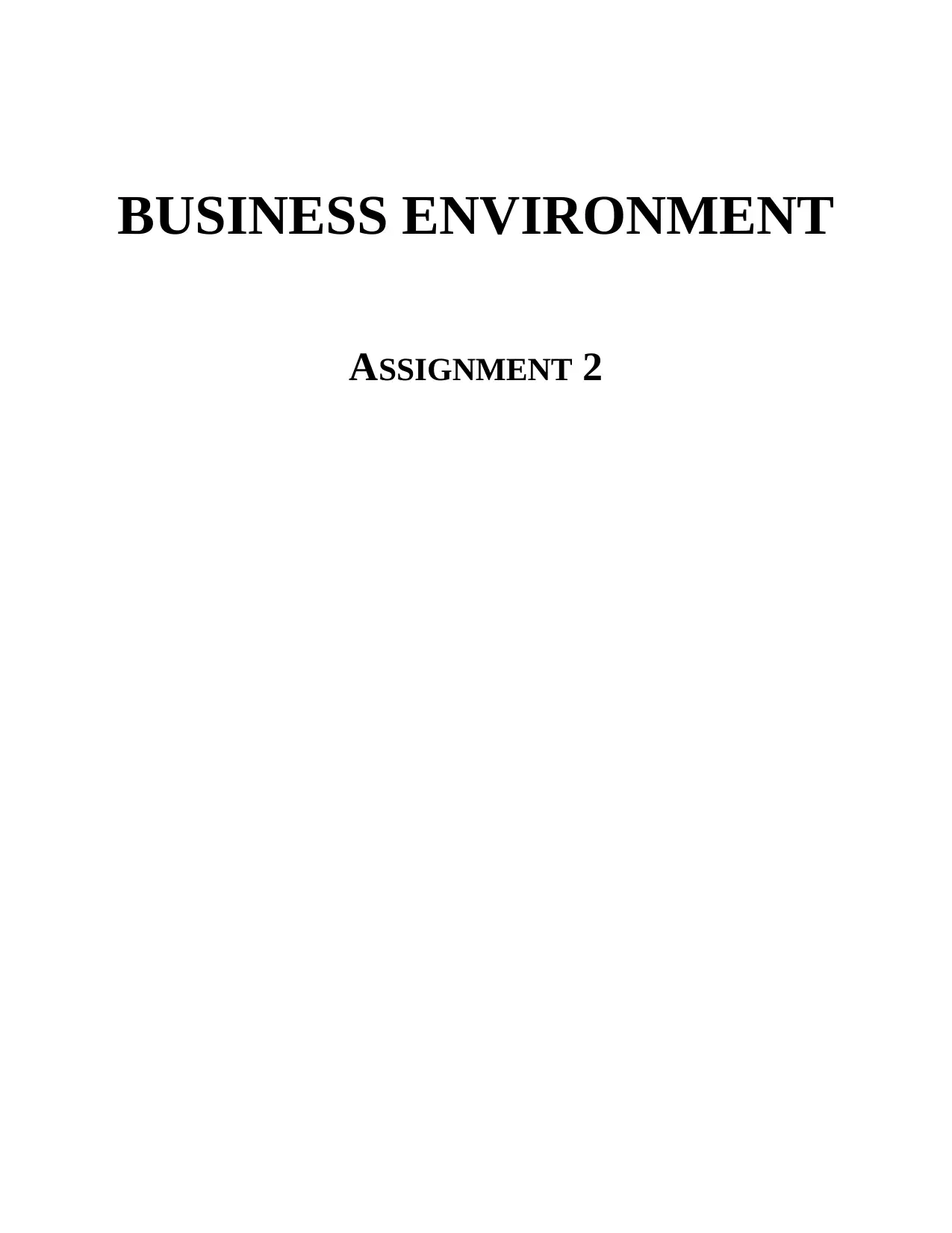
BUSINESS ENVIRONMENT
ASSIGNMENT 2
ASSIGNMENT 2
Secure Best Marks with AI Grader
Need help grading? Try our AI Grader for instant feedback on your assignments.
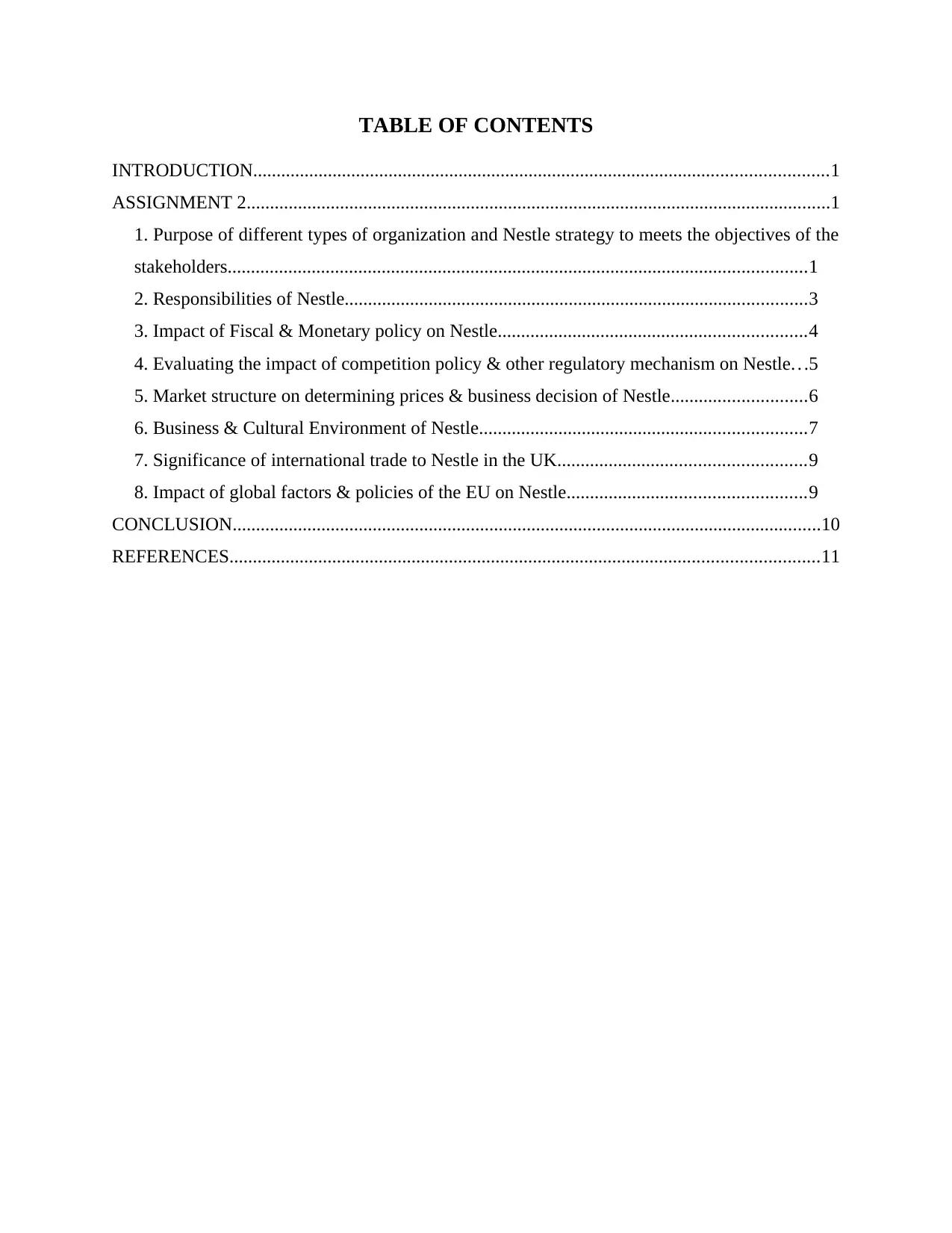
TABLE OF CONTENTS
INTRODUCTION...........................................................................................................................1
ASSIGNMENT 2.............................................................................................................................1
1. Purpose of different types of organization and Nestle strategy to meets the objectives of the
stakeholders............................................................................................................................1
2. Responsibilities of Nestle...................................................................................................3
3. Impact of Fiscal & Monetary policy on Nestle..................................................................4
4. Evaluating the impact of competition policy & other regulatory mechanism on Nestle.. .5
5. Market structure on determining prices & business decision of Nestle.............................6
6. Business & Cultural Environment of Nestle......................................................................7
7. Significance of international trade to Nestle in the UK.....................................................9
8. Impact of global factors & policies of the EU on Nestle...................................................9
CONCLUSION..............................................................................................................................10
REFERENCES..............................................................................................................................11
INTRODUCTION...........................................................................................................................1
ASSIGNMENT 2.............................................................................................................................1
1. Purpose of different types of organization and Nestle strategy to meets the objectives of the
stakeholders............................................................................................................................1
2. Responsibilities of Nestle...................................................................................................3
3. Impact of Fiscal & Monetary policy on Nestle..................................................................4
4. Evaluating the impact of competition policy & other regulatory mechanism on Nestle.. .5
5. Market structure on determining prices & business decision of Nestle.............................6
6. Business & Cultural Environment of Nestle......................................................................7
7. Significance of international trade to Nestle in the UK.....................................................9
8. Impact of global factors & policies of the EU on Nestle...................................................9
CONCLUSION..............................................................................................................................10
REFERENCES..............................................................................................................................11
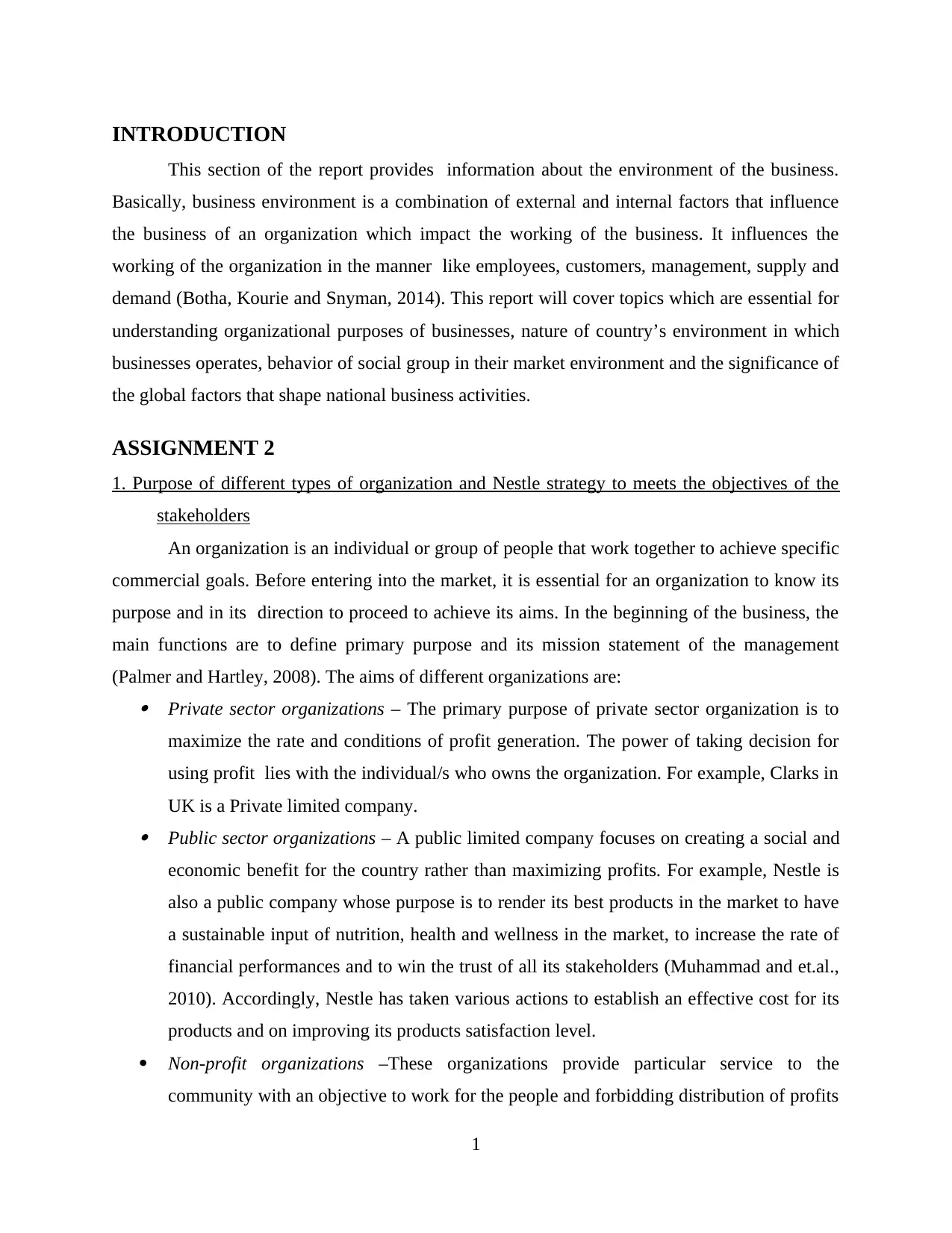
INTRODUCTION
This section of the report provides information about the environment of the business.
Basically, business environment is a combination of external and internal factors that influence
the business of an organization which impact the working of the business. It influences the
working of the organization in the manner like employees, customers, management, supply and
demand (Botha, Kourie and Snyman, 2014). This report will cover topics which are essential for
understanding organizational purposes of businesses, nature of country’s environment in which
businesses operates, behavior of social group in their market environment and the significance of
the global factors that shape national business activities.
ASSIGNMENT 2
1. Purpose of different types of organization and Nestle strategy to meets the objectives of the
stakeholders
An organization is an individual or group of people that work together to achieve specific
commercial goals. Before entering into the market, it is essential for an organization to know its
purpose and in its direction to proceed to achieve its aims. In the beginning of the business, the
main functions are to define primary purpose and its mission statement of the management
(Palmer and Hartley, 2008). The aims of different organizations are: Private sector organizations – The primary purpose of private sector organization is to
maximize the rate and conditions of profit generation. The power of taking decision for
using profit lies with the individual/s who owns the organization. For example, Clarks in
UK is a Private limited company. Public sector organizations – A public limited company focuses on creating a social and
economic benefit for the country rather than maximizing profits. For example, Nestle is
also a public company whose purpose is to render its best products in the market to have
a sustainable input of nutrition, health and wellness in the market, to increase the rate of
financial performances and to win the trust of all its stakeholders (Muhammad and et.al.,
2010). Accordingly, Nestle has taken various actions to establish an effective cost for its
products and on improving its products satisfaction level.
Non-profit organizations –These organizations provide particular service to the
community with an objective to work for the people and forbidding distribution of profits
1
This section of the report provides information about the environment of the business.
Basically, business environment is a combination of external and internal factors that influence
the business of an organization which impact the working of the business. It influences the
working of the organization in the manner like employees, customers, management, supply and
demand (Botha, Kourie and Snyman, 2014). This report will cover topics which are essential for
understanding organizational purposes of businesses, nature of country’s environment in which
businesses operates, behavior of social group in their market environment and the significance of
the global factors that shape national business activities.
ASSIGNMENT 2
1. Purpose of different types of organization and Nestle strategy to meets the objectives of the
stakeholders
An organization is an individual or group of people that work together to achieve specific
commercial goals. Before entering into the market, it is essential for an organization to know its
purpose and in its direction to proceed to achieve its aims. In the beginning of the business, the
main functions are to define primary purpose and its mission statement of the management
(Palmer and Hartley, 2008). The aims of different organizations are: Private sector organizations – The primary purpose of private sector organization is to
maximize the rate and conditions of profit generation. The power of taking decision for
using profit lies with the individual/s who owns the organization. For example, Clarks in
UK is a Private limited company. Public sector organizations – A public limited company focuses on creating a social and
economic benefit for the country rather than maximizing profits. For example, Nestle is
also a public company whose purpose is to render its best products in the market to have
a sustainable input of nutrition, health and wellness in the market, to increase the rate of
financial performances and to win the trust of all its stakeholders (Muhammad and et.al.,
2010). Accordingly, Nestle has taken various actions to establish an effective cost for its
products and on improving its products satisfaction level.
Non-profit organizations –These organizations provide particular service to the
community with an objective to work for the people and forbidding distribution of profits
1
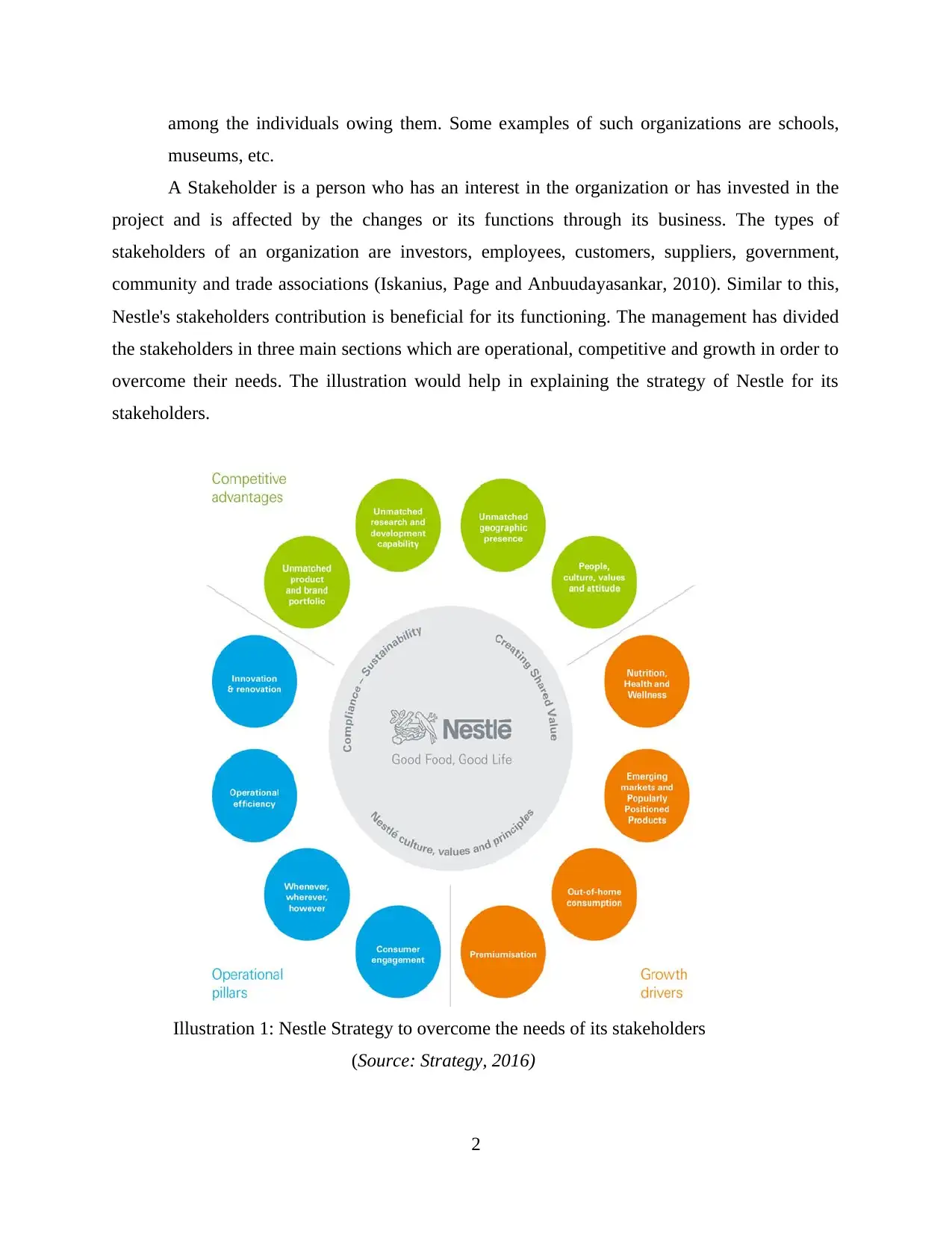
among the individuals owing them. Some examples of such organizations are schools,
museums, etc.
A Stakeholder is a person who has an interest in the organization or has invested in the
project and is affected by the changes or its functions through its business. The types of
stakeholders of an organization are investors, employees, customers, suppliers, government,
community and trade associations (Iskanius, Page and Anbuudayasankar, 2010). Similar to this,
Nestle's stakeholders contribution is beneficial for its functioning. The management has divided
the stakeholders in three main sections which are operational, competitive and growth in order to
overcome their needs. The illustration would help in explaining the strategy of Nestle for its
stakeholders.
Illustration 1: Nestle Strategy to overcome the needs of its stakeholders
(Source: Strategy, 2016)
2
museums, etc.
A Stakeholder is a person who has an interest in the organization or has invested in the
project and is affected by the changes or its functions through its business. The types of
stakeholders of an organization are investors, employees, customers, suppliers, government,
community and trade associations (Iskanius, Page and Anbuudayasankar, 2010). Similar to this,
Nestle's stakeholders contribution is beneficial for its functioning. The management has divided
the stakeholders in three main sections which are operational, competitive and growth in order to
overcome their needs. The illustration would help in explaining the strategy of Nestle for its
stakeholders.
Illustration 1: Nestle Strategy to overcome the needs of its stakeholders
(Source: Strategy, 2016)
2
Secure Best Marks with AI Grader
Need help grading? Try our AI Grader for instant feedback on your assignments.
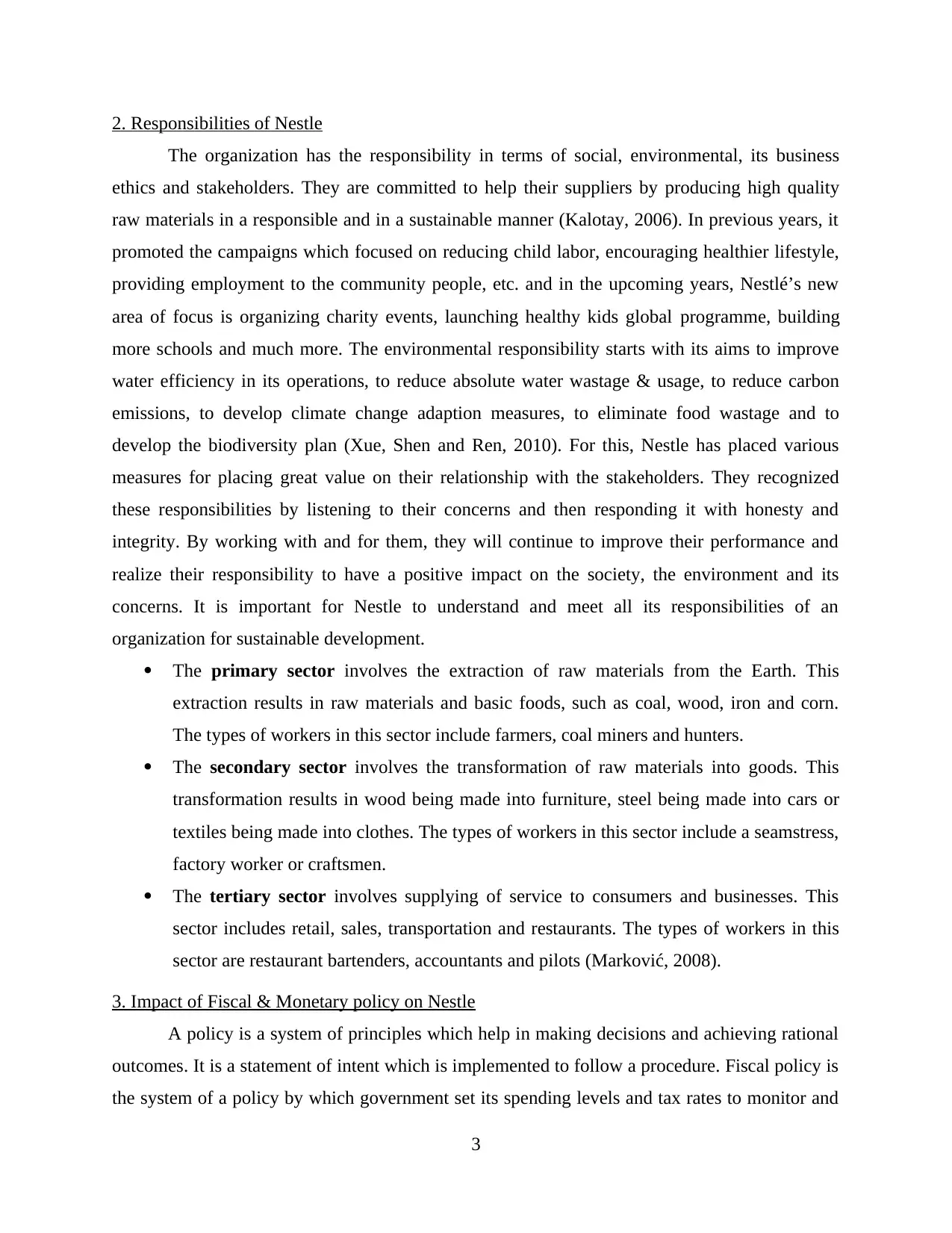
2. Responsibilities of Nestle
The organization has the responsibility in terms of social, environmental, its business
ethics and stakeholders. They are committed to help their suppliers by producing high quality
raw materials in a responsible and in a sustainable manner (Kalotay, 2006). In previous years, it
promoted the campaigns which focused on reducing child labor, encouraging healthier lifestyle,
providing employment to the community people, etc. and in the upcoming years, Nestlé’s new
area of focus is organizing charity events, launching healthy kids global programme, building
more schools and much more. The environmental responsibility starts with its aims to improve
water efficiency in its operations, to reduce absolute water wastage & usage, to reduce carbon
emissions, to develop climate change adaption measures, to eliminate food wastage and to
develop the biodiversity plan (Xue, Shen and Ren, 2010). For this, Nestle has placed various
measures for placing great value on their relationship with the stakeholders. They recognized
these responsibilities by listening to their concerns and then responding it with honesty and
integrity. By working with and for them, they will continue to improve their performance and
realize their responsibility to have a positive impact on the society, the environment and its
concerns. It is important for Nestle to understand and meet all its responsibilities of an
organization for sustainable development.
The primary sector involves the extraction of raw materials from the Earth. This
extraction results in raw materials and basic foods, such as coal, wood, iron and corn.
The types of workers in this sector include farmers, coal miners and hunters.
The secondary sector involves the transformation of raw materials into goods. This
transformation results in wood being made into furniture, steel being made into cars or
textiles being made into clothes. The types of workers in this sector include a seamstress,
factory worker or craftsmen.
The tertiary sector involves supplying of service to consumers and businesses. This
sector includes retail, sales, transportation and restaurants. The types of workers in this
sector are restaurant bartenders, accountants and pilots (Marković, 2008).
3. Impact of Fiscal & Monetary policy on Nestle
A policy is a system of principles which help in making decisions and achieving rational
outcomes. It is a statement of intent which is implemented to follow a procedure. Fiscal policy is
the system of a policy by which government set its spending levels and tax rates to monitor and
3
The organization has the responsibility in terms of social, environmental, its business
ethics and stakeholders. They are committed to help their suppliers by producing high quality
raw materials in a responsible and in a sustainable manner (Kalotay, 2006). In previous years, it
promoted the campaigns which focused on reducing child labor, encouraging healthier lifestyle,
providing employment to the community people, etc. and in the upcoming years, Nestlé’s new
area of focus is organizing charity events, launching healthy kids global programme, building
more schools and much more. The environmental responsibility starts with its aims to improve
water efficiency in its operations, to reduce absolute water wastage & usage, to reduce carbon
emissions, to develop climate change adaption measures, to eliminate food wastage and to
develop the biodiversity plan (Xue, Shen and Ren, 2010). For this, Nestle has placed various
measures for placing great value on their relationship with the stakeholders. They recognized
these responsibilities by listening to their concerns and then responding it with honesty and
integrity. By working with and for them, they will continue to improve their performance and
realize their responsibility to have a positive impact on the society, the environment and its
concerns. It is important for Nestle to understand and meet all its responsibilities of an
organization for sustainable development.
The primary sector involves the extraction of raw materials from the Earth. This
extraction results in raw materials and basic foods, such as coal, wood, iron and corn.
The types of workers in this sector include farmers, coal miners and hunters.
The secondary sector involves the transformation of raw materials into goods. This
transformation results in wood being made into furniture, steel being made into cars or
textiles being made into clothes. The types of workers in this sector include a seamstress,
factory worker or craftsmen.
The tertiary sector involves supplying of service to consumers and businesses. This
sector includes retail, sales, transportation and restaurants. The types of workers in this
sector are restaurant bartenders, accountants and pilots (Marković, 2008).
3. Impact of Fiscal & Monetary policy on Nestle
A policy is a system of principles which help in making decisions and achieving rational
outcomes. It is a statement of intent which is implemented to follow a procedure. Fiscal policy is
the system of a policy by which government set its spending levels and tax rates to monitor and
3
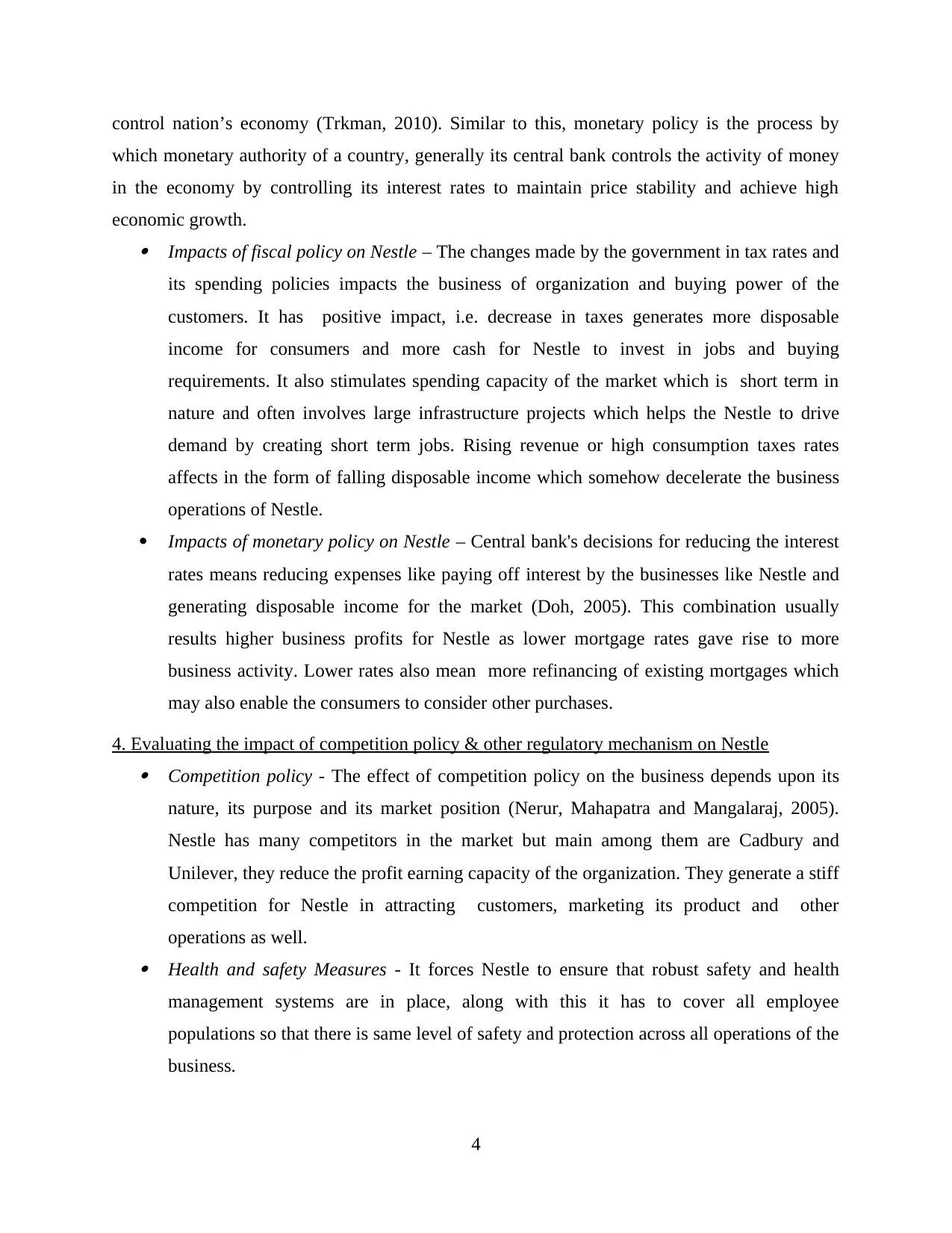
control nation’s economy (Trkman, 2010). Similar to this, monetary policy is the process by
which monetary authority of a country, generally its central bank controls the activity of money
in the economy by controlling its interest rates to maintain price stability and achieve high
economic growth. Impacts of fiscal policy on Nestle – The changes made by the government in tax rates and
its spending policies impacts the business of organization and buying power of the
customers. It has positive impact, i.e. decrease in taxes generates more disposable
income for consumers and more cash for Nestle to invest in jobs and buying
requirements. It also stimulates spending capacity of the market which is short term in
nature and often involves large infrastructure projects which helps the Nestle to drive
demand by creating short term jobs. Rising revenue or high consumption taxes rates
affects in the form of falling disposable income which somehow decelerate the business
operations of Nestle.
Impacts of monetary policy on Nestle – Central bank's decisions for reducing the interest
rates means reducing expenses like paying off interest by the businesses like Nestle and
generating disposable income for the market (Doh, 2005). This combination usually
results higher business profits for Nestle as lower mortgage rates gave rise to more
business activity. Lower rates also mean more refinancing of existing mortgages which
may also enable the consumers to consider other purchases.
4. Evaluating the impact of competition policy & other regulatory mechanism on Nestle Competition policy - The effect of competition policy on the business depends upon its
nature, its purpose and its market position (Nerur, Mahapatra and Mangalaraj, 2005).
Nestle has many competitors in the market but main among them are Cadbury and
Unilever, they reduce the profit earning capacity of the organization. They generate a stiff
competition for Nestle in attracting customers, marketing its product and other
operations as well. Health and safety Measures - It forces Nestle to ensure that robust safety and health
management systems are in place, along with this it has to cover all employee
populations so that there is same level of safety and protection across all operations of the
business.
4
which monetary authority of a country, generally its central bank controls the activity of money
in the economy by controlling its interest rates to maintain price stability and achieve high
economic growth. Impacts of fiscal policy on Nestle – The changes made by the government in tax rates and
its spending policies impacts the business of organization and buying power of the
customers. It has positive impact, i.e. decrease in taxes generates more disposable
income for consumers and more cash for Nestle to invest in jobs and buying
requirements. It also stimulates spending capacity of the market which is short term in
nature and often involves large infrastructure projects which helps the Nestle to drive
demand by creating short term jobs. Rising revenue or high consumption taxes rates
affects in the form of falling disposable income which somehow decelerate the business
operations of Nestle.
Impacts of monetary policy on Nestle – Central bank's decisions for reducing the interest
rates means reducing expenses like paying off interest by the businesses like Nestle and
generating disposable income for the market (Doh, 2005). This combination usually
results higher business profits for Nestle as lower mortgage rates gave rise to more
business activity. Lower rates also mean more refinancing of existing mortgages which
may also enable the consumers to consider other purchases.
4. Evaluating the impact of competition policy & other regulatory mechanism on Nestle Competition policy - The effect of competition policy on the business depends upon its
nature, its purpose and its market position (Nerur, Mahapatra and Mangalaraj, 2005).
Nestle has many competitors in the market but main among them are Cadbury and
Unilever, they reduce the profit earning capacity of the organization. They generate a stiff
competition for Nestle in attracting customers, marketing its product and other
operations as well. Health and safety Measures - It forces Nestle to ensure that robust safety and health
management systems are in place, along with this it has to cover all employee
populations so that there is same level of safety and protection across all operations of the
business.
4
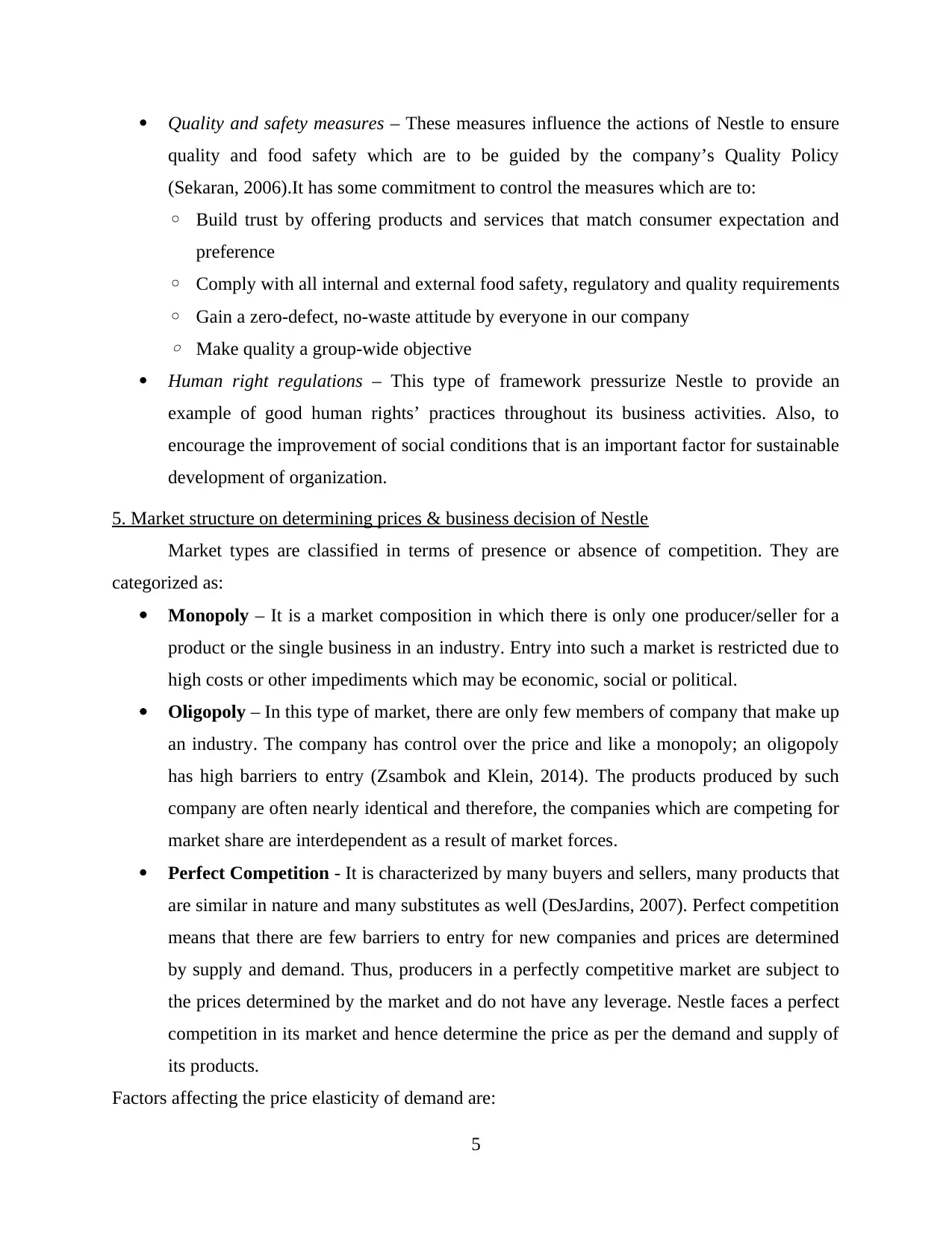
Quality and safety measures – These measures influence the actions of Nestle to ensure
quality and food safety which are to be guided by the company’s Quality Policy
(Sekaran, 2006).It has some commitment to control the measures which are to:
◦ Build trust by offering products and services that match consumer expectation and
preference
◦ Comply with all internal and external food safety, regulatory and quality requirements
◦ Gain a zero-defect, no-waste attitude by everyone in our company
◦ Make quality a group-wide objective
Human right regulations – This type of framework pressurize Nestle to provide an
example of good human rights’ practices throughout its business activities. Also, to
encourage the improvement of social conditions that is an important factor for sustainable
development of organization.
5. Market structure on determining prices & business decision of Nestle
Market types are classified in terms of presence or absence of competition. They are
categorized as:
Monopoly – It is a market composition in which there is only one producer/seller for a
product or the single business in an industry. Entry into such a market is restricted due to
high costs or other impediments which may be economic, social or political.
Oligopoly – In this type of market, there are only few members of company that make up
an industry. The company has control over the price and like a monopoly; an oligopoly
has high barriers to entry (Zsambok and Klein, 2014). The products produced by such
company are often nearly identical and therefore, the companies which are competing for
market share are interdependent as a result of market forces.
Perfect Competition - It is characterized by many buyers and sellers, many products that
are similar in nature and many substitutes as well (DesJardins, 2007). Perfect competition
means that there are few barriers to entry for new companies and prices are determined
by supply and demand. Thus, producers in a perfectly competitive market are subject to
the prices determined by the market and do not have any leverage. Nestle faces a perfect
competition in its market and hence determine the price as per the demand and supply of
its products.
Factors affecting the price elasticity of demand are:
5
quality and food safety which are to be guided by the company’s Quality Policy
(Sekaran, 2006).It has some commitment to control the measures which are to:
◦ Build trust by offering products and services that match consumer expectation and
preference
◦ Comply with all internal and external food safety, regulatory and quality requirements
◦ Gain a zero-defect, no-waste attitude by everyone in our company
◦ Make quality a group-wide objective
Human right regulations – This type of framework pressurize Nestle to provide an
example of good human rights’ practices throughout its business activities. Also, to
encourage the improvement of social conditions that is an important factor for sustainable
development of organization.
5. Market structure on determining prices & business decision of Nestle
Market types are classified in terms of presence or absence of competition. They are
categorized as:
Monopoly – It is a market composition in which there is only one producer/seller for a
product or the single business in an industry. Entry into such a market is restricted due to
high costs or other impediments which may be economic, social or political.
Oligopoly – In this type of market, there are only few members of company that make up
an industry. The company has control over the price and like a monopoly; an oligopoly
has high barriers to entry (Zsambok and Klein, 2014). The products produced by such
company are often nearly identical and therefore, the companies which are competing for
market share are interdependent as a result of market forces.
Perfect Competition - It is characterized by many buyers and sellers, many products that
are similar in nature and many substitutes as well (DesJardins, 2007). Perfect competition
means that there are few barriers to entry for new companies and prices are determined
by supply and demand. Thus, producers in a perfectly competitive market are subject to
the prices determined by the market and do not have any leverage. Nestle faces a perfect
competition in its market and hence determine the price as per the demand and supply of
its products.
Factors affecting the price elasticity of demand are:
5
Paraphrase This Document
Need a fresh take? Get an instant paraphrase of this document with our AI Paraphraser
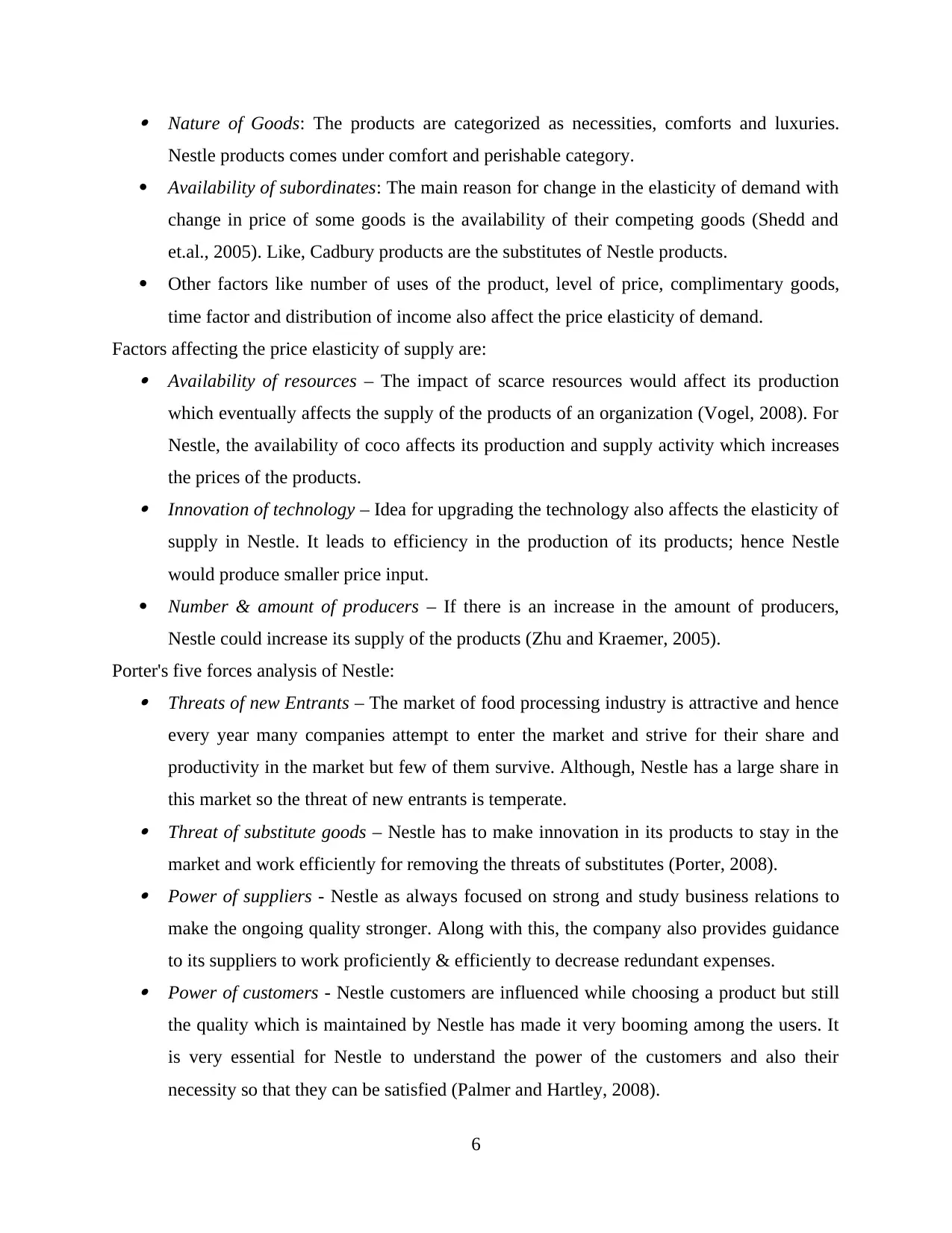
Nature of Goods: The products are categorized as necessities, comforts and luxuries.
Nestle products comes under comfort and perishable category.
Availability of subordinates: The main reason for change in the elasticity of demand with
change in price of some goods is the availability of their competing goods (Shedd and
et.al., 2005). Like, Cadbury products are the substitutes of Nestle products.
Other factors like number of uses of the product, level of price, complimentary goods,
time factor and distribution of income also affect the price elasticity of demand.
Factors affecting the price elasticity of supply are: Availability of resources – The impact of scarce resources would affect its production
which eventually affects the supply of the products of an organization (Vogel, 2008). For
Nestle, the availability of coco affects its production and supply activity which increases
the prices of the products. Innovation of technology – Idea for upgrading the technology also affects the elasticity of
supply in Nestle. It leads to efficiency in the production of its products; hence Nestle
would produce smaller price input.
Number & amount of producers – If there is an increase in the amount of producers,
Nestle could increase its supply of the products (Zhu and Kraemer, 2005).
Porter's five forces analysis of Nestle: Threats of new Entrants – The market of food processing industry is attractive and hence
every year many companies attempt to enter the market and strive for their share and
productivity in the market but few of them survive. Although, Nestle has a large share in
this market so the threat of new entrants is temperate. Threat of substitute goods – Nestle has to make innovation in its products to stay in the
market and work efficiently for removing the threats of substitutes (Porter, 2008). Power of suppliers - Nestle as always focused on strong and study business relations to
make the ongoing quality stronger. Along with this, the company also provides guidance
to its suppliers to work proficiently & efficiently to decrease redundant expenses. Power of customers - Nestle customers are influenced while choosing a product but still
the quality which is maintained by Nestle has made it very booming among the users. It
is very essential for Nestle to understand the power of the customers and also their
necessity so that they can be satisfied (Palmer and Hartley, 2008).
6
Nestle products comes under comfort and perishable category.
Availability of subordinates: The main reason for change in the elasticity of demand with
change in price of some goods is the availability of their competing goods (Shedd and
et.al., 2005). Like, Cadbury products are the substitutes of Nestle products.
Other factors like number of uses of the product, level of price, complimentary goods,
time factor and distribution of income also affect the price elasticity of demand.
Factors affecting the price elasticity of supply are: Availability of resources – The impact of scarce resources would affect its production
which eventually affects the supply of the products of an organization (Vogel, 2008). For
Nestle, the availability of coco affects its production and supply activity which increases
the prices of the products. Innovation of technology – Idea for upgrading the technology also affects the elasticity of
supply in Nestle. It leads to efficiency in the production of its products; hence Nestle
would produce smaller price input.
Number & amount of producers – If there is an increase in the amount of producers,
Nestle could increase its supply of the products (Zhu and Kraemer, 2005).
Porter's five forces analysis of Nestle: Threats of new Entrants – The market of food processing industry is attractive and hence
every year many companies attempt to enter the market and strive for their share and
productivity in the market but few of them survive. Although, Nestle has a large share in
this market so the threat of new entrants is temperate. Threat of substitute goods – Nestle has to make innovation in its products to stay in the
market and work efficiently for removing the threats of substitutes (Porter, 2008). Power of suppliers - Nestle as always focused on strong and study business relations to
make the ongoing quality stronger. Along with this, the company also provides guidance
to its suppliers to work proficiently & efficiently to decrease redundant expenses. Power of customers - Nestle customers are influenced while choosing a product but still
the quality which is maintained by Nestle has made it very booming among the users. It
is very essential for Nestle to understand the power of the customers and also their
necessity so that they can be satisfied (Palmer and Hartley, 2008).
6
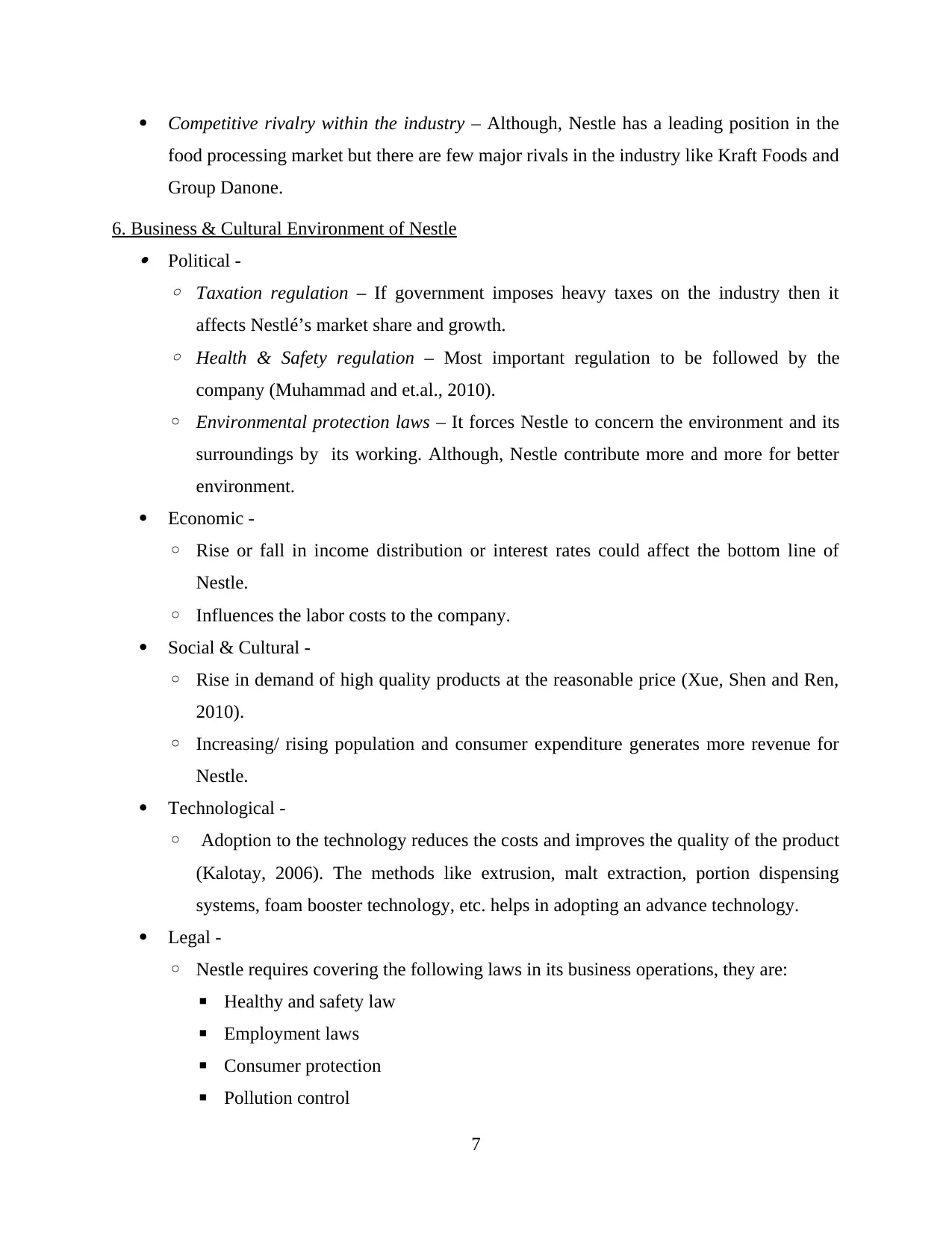
Competitive rivalry within the industry – Although, Nestle has a leading position in the
food processing market but there are few major rivals in the industry like Kraft Foods and
Group Danone.
6. Business & Cultural Environment of Nestle Political -
◦ Taxation regulation – If government imposes heavy taxes on the industry then it
affects Nestlé’s market share and growth.
◦ Health & Safety regulation – Most important regulation to be followed by the
company (Muhammad and et.al., 2010).
◦ Environmental protection laws – It forces Nestle to concern the environment and its
surroundings by its working. Although, Nestle contribute more and more for better
environment.
Economic -
◦ Rise or fall in income distribution or interest rates could affect the bottom line of
Nestle.
◦ Influences the labor costs to the company.
Social & Cultural -
◦ Rise in demand of high quality products at the reasonable price (Xue, Shen and Ren,
2010).
◦ Increasing/ rising population and consumer expenditure generates more revenue for
Nestle.
Technological -
◦ Adoption to the technology reduces the costs and improves the quality of the product
(Kalotay, 2006). The methods like extrusion, malt extraction, portion dispensing
systems, foam booster technology, etc. helps in adopting an advance technology.
Legal -
◦ Nestle requires covering the following laws in its business operations, they are:
▪ Healthy and safety law
▪ Employment laws
▪ Consumer protection
▪ Pollution control
7
food processing market but there are few major rivals in the industry like Kraft Foods and
Group Danone.
6. Business & Cultural Environment of Nestle Political -
◦ Taxation regulation – If government imposes heavy taxes on the industry then it
affects Nestlé’s market share and growth.
◦ Health & Safety regulation – Most important regulation to be followed by the
company (Muhammad and et.al., 2010).
◦ Environmental protection laws – It forces Nestle to concern the environment and its
surroundings by its working. Although, Nestle contribute more and more for better
environment.
Economic -
◦ Rise or fall in income distribution or interest rates could affect the bottom line of
Nestle.
◦ Influences the labor costs to the company.
Social & Cultural -
◦ Rise in demand of high quality products at the reasonable price (Xue, Shen and Ren,
2010).
◦ Increasing/ rising population and consumer expenditure generates more revenue for
Nestle.
Technological -
◦ Adoption to the technology reduces the costs and improves the quality of the product
(Kalotay, 2006). The methods like extrusion, malt extraction, portion dispensing
systems, foam booster technology, etc. helps in adopting an advance technology.
Legal -
◦ Nestle requires covering the following laws in its business operations, they are:
▪ Healthy and safety law
▪ Employment laws
▪ Consumer protection
▪ Pollution control
7
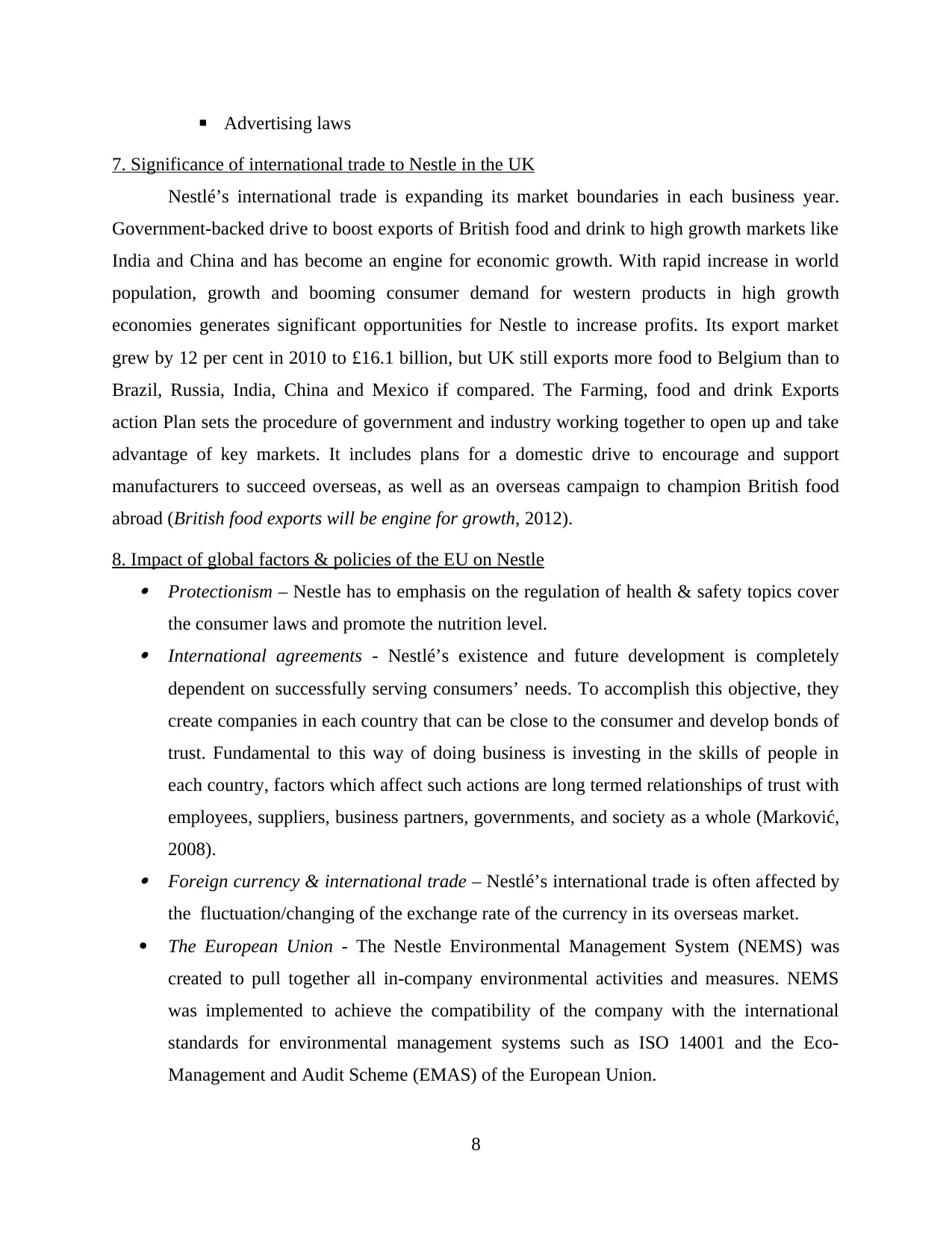
▪ Advertising laws
7. Significance of international trade to Nestle in the UK
Nestlé’s international trade is expanding its market boundaries in each business year.
Government-backed drive to boost exports of British food and drink to high growth markets like
India and China and has become an engine for economic growth. With rapid increase in world
population, growth and booming consumer demand for western products in high growth
economies generates significant opportunities for Nestle to increase profits. Its export market
grew by 12 per cent in 2010 to £16.1 billion, but UK still exports more food to Belgium than to
Brazil, Russia, India, China and Mexico if compared. The Farming, food and drink Exports
action Plan sets the procedure of government and industry working together to open up and take
advantage of key markets. It includes plans for a domestic drive to encourage and support
manufacturers to succeed overseas, as well as an overseas campaign to champion British food
abroad (British food exports will be engine for growth, 2012).
8. Impact of global factors & policies of the EU on Nestle Protectionism – Nestle has to emphasis on the regulation of health & safety topics cover
the consumer laws and promote the nutrition level. International agreements - Nestlé’s existence and future development is completely
dependent on successfully serving consumers’ needs. To accomplish this objective, they
create companies in each country that can be close to the consumer and develop bonds of
trust. Fundamental to this way of doing business is investing in the skills of people in
each country, factors which affect such actions are long termed relationships of trust with
employees, suppliers, business partners, governments, and society as a whole (Marković,
2008). Foreign currency & international trade – Nestlé’s international trade is often affected by
the fluctuation/changing of the exchange rate of the currency in its overseas market.
The European Union - The Nestle Environmental Management System (NEMS) was
created to pull together all in-company environmental activities and measures. NEMS
was implemented to achieve the compatibility of the company with the international
standards for environmental management systems such as ISO 14001 and the Eco-
Management and Audit Scheme (EMAS) of the European Union.
8
7. Significance of international trade to Nestle in the UK
Nestlé’s international trade is expanding its market boundaries in each business year.
Government-backed drive to boost exports of British food and drink to high growth markets like
India and China and has become an engine for economic growth. With rapid increase in world
population, growth and booming consumer demand for western products in high growth
economies generates significant opportunities for Nestle to increase profits. Its export market
grew by 12 per cent in 2010 to £16.1 billion, but UK still exports more food to Belgium than to
Brazil, Russia, India, China and Mexico if compared. The Farming, food and drink Exports
action Plan sets the procedure of government and industry working together to open up and take
advantage of key markets. It includes plans for a domestic drive to encourage and support
manufacturers to succeed overseas, as well as an overseas campaign to champion British food
abroad (British food exports will be engine for growth, 2012).
8. Impact of global factors & policies of the EU on Nestle Protectionism – Nestle has to emphasis on the regulation of health & safety topics cover
the consumer laws and promote the nutrition level. International agreements - Nestlé’s existence and future development is completely
dependent on successfully serving consumers’ needs. To accomplish this objective, they
create companies in each country that can be close to the consumer and develop bonds of
trust. Fundamental to this way of doing business is investing in the skills of people in
each country, factors which affect such actions are long termed relationships of trust with
employees, suppliers, business partners, governments, and society as a whole (Marković,
2008). Foreign currency & international trade – Nestlé’s international trade is often affected by
the fluctuation/changing of the exchange rate of the currency in its overseas market.
The European Union - The Nestle Environmental Management System (NEMS) was
created to pull together all in-company environmental activities and measures. NEMS
was implemented to achieve the compatibility of the company with the international
standards for environmental management systems such as ISO 14001 and the Eco-
Management and Audit Scheme (EMAS) of the European Union.
8
Secure Best Marks with AI Grader
Need help grading? Try our AI Grader for instant feedback on your assignments.
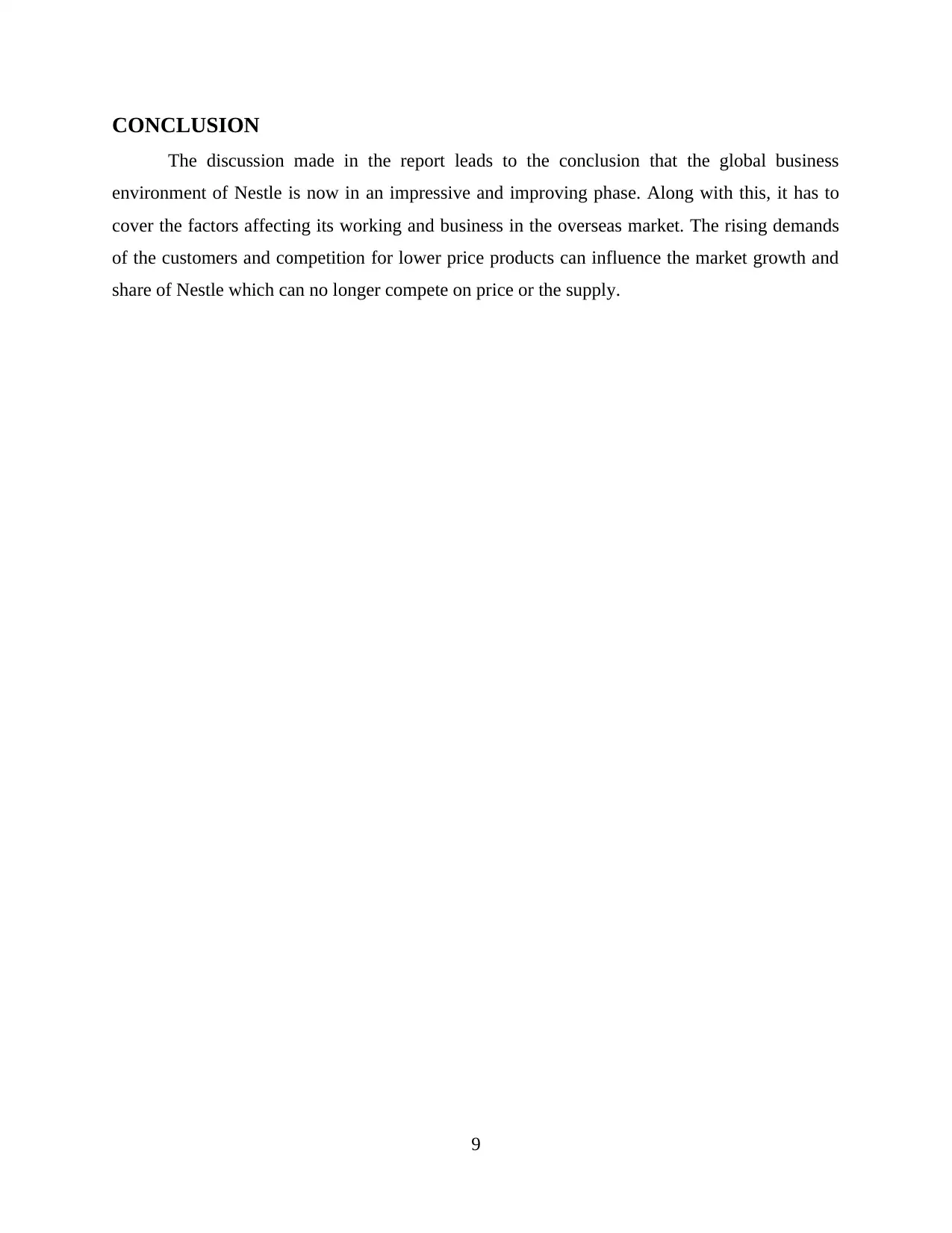
CONCLUSION
The discussion made in the report leads to the conclusion that the global business
environment of Nestle is now in an impressive and improving phase. Along with this, it has to
cover the factors affecting its working and business in the overseas market. The rising demands
of the customers and competition for lower price products can influence the market growth and
share of Nestle which can no longer compete on price or the supply.
9
The discussion made in the report leads to the conclusion that the global business
environment of Nestle is now in an impressive and improving phase. Along with this, it has to
cover the factors affecting its working and business in the overseas market. The rising demands
of the customers and competition for lower price products can influence the market growth and
share of Nestle which can no longer compete on price or the supply.
9
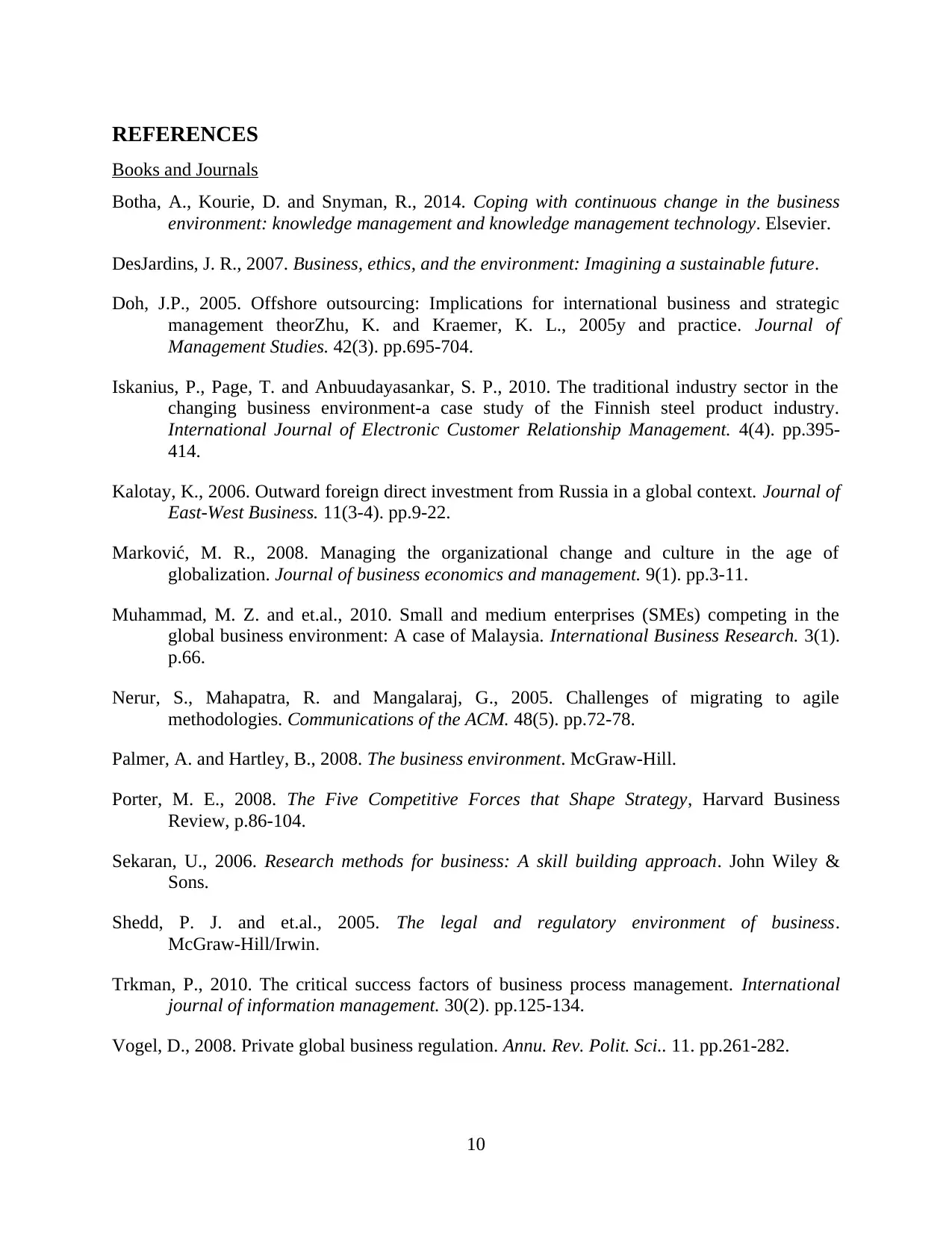
REFERENCES
Books and Journals
Botha, A., Kourie, D. and Snyman, R., 2014. Coping with continuous change in the business
environment: knowledge management and knowledge management technology. Elsevier.
DesJardins, J. R., 2007. Business, ethics, and the environment: Imagining a sustainable future.
Doh, J.P., 2005. Offshore outsourcing: Implications for international business and strategic
management theorZhu, K. and Kraemer, K. L., 2005y and practice. Journal of
Management Studies. 42(3). pp.695-704.
Iskanius, P., Page, T. and Anbuudayasankar, S. P., 2010. The traditional industry sector in the
changing business environment-a case study of the Finnish steel product industry.
International Journal of Electronic Customer Relationship Management. 4(4). pp.395-
414.
Kalotay, K., 2006. Outward foreign direct investment from Russia in a global context. Journal of
East-West Business. 11(3-4). pp.9-22.
Marković, M. R., 2008. Managing the organizational change and culture in the age of
globalization. Journal of business economics and management. 9(1). pp.3-11.
Muhammad, M. Z. and et.al., 2010. Small and medium enterprises (SMEs) competing in the
global business environment: A case of Malaysia. International Business Research. 3(1).
p.66.
Nerur, S., Mahapatra, R. and Mangalaraj, G., 2005. Challenges of migrating to agile
methodologies. Communications of the ACM. 48(5). pp.72-78.
Palmer, A. and Hartley, B., 2008. The business environment. McGraw-Hill.
Porter, M. E., 2008. The Five Competitive Forces that Shape Strategy, Harvard Business
Review, p.86-104.
Sekaran, U., 2006. Research methods for business: A skill building approach. John Wiley &
Sons.
Shedd, P. J. and et.al., 2005. The legal and regulatory environment of business.
McGraw-Hill/Irwin.
Trkman, P., 2010. The critical success factors of business process management. International
journal of information management. 30(2). pp.125-134.
Vogel, D., 2008. Private global business regulation. Annu. Rev. Polit. Sci.. 11. pp.261-282.
10
Books and Journals
Botha, A., Kourie, D. and Snyman, R., 2014. Coping with continuous change in the business
environment: knowledge management and knowledge management technology. Elsevier.
DesJardins, J. R., 2007. Business, ethics, and the environment: Imagining a sustainable future.
Doh, J.P., 2005. Offshore outsourcing: Implications for international business and strategic
management theorZhu, K. and Kraemer, K. L., 2005y and practice. Journal of
Management Studies. 42(3). pp.695-704.
Iskanius, P., Page, T. and Anbuudayasankar, S. P., 2010. The traditional industry sector in the
changing business environment-a case study of the Finnish steel product industry.
International Journal of Electronic Customer Relationship Management. 4(4). pp.395-
414.
Kalotay, K., 2006. Outward foreign direct investment from Russia in a global context. Journal of
East-West Business. 11(3-4). pp.9-22.
Marković, M. R., 2008. Managing the organizational change and culture in the age of
globalization. Journal of business economics and management. 9(1). pp.3-11.
Muhammad, M. Z. and et.al., 2010. Small and medium enterprises (SMEs) competing in the
global business environment: A case of Malaysia. International Business Research. 3(1).
p.66.
Nerur, S., Mahapatra, R. and Mangalaraj, G., 2005. Challenges of migrating to agile
methodologies. Communications of the ACM. 48(5). pp.72-78.
Palmer, A. and Hartley, B., 2008. The business environment. McGraw-Hill.
Porter, M. E., 2008. The Five Competitive Forces that Shape Strategy, Harvard Business
Review, p.86-104.
Sekaran, U., 2006. Research methods for business: A skill building approach. John Wiley &
Sons.
Shedd, P. J. and et.al., 2005. The legal and regulatory environment of business.
McGraw-Hill/Irwin.
Trkman, P., 2010. The critical success factors of business process management. International
journal of information management. 30(2). pp.125-134.
Vogel, D., 2008. Private global business regulation. Annu. Rev. Polit. Sci.. 11. pp.261-282.
10
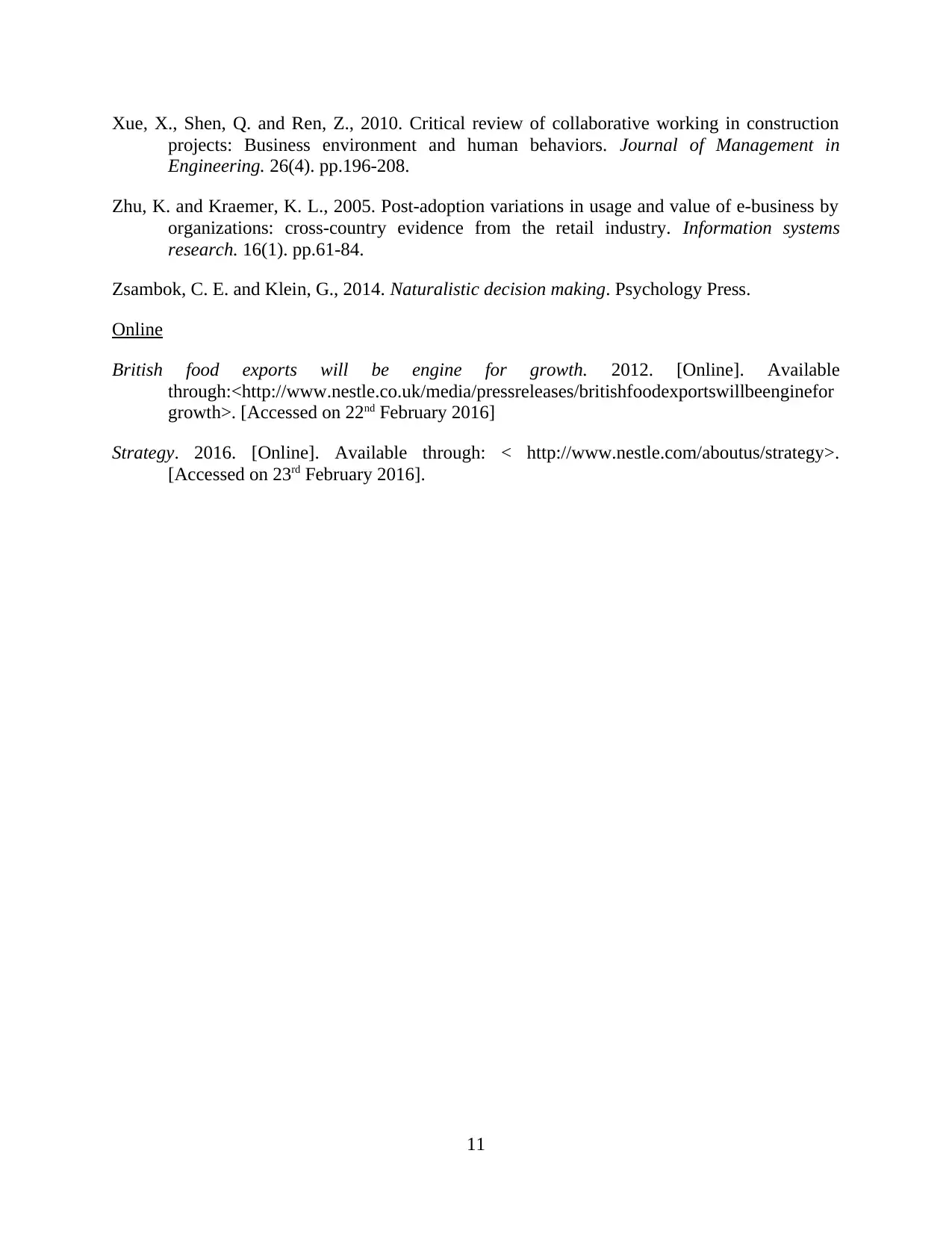
Xue, X., Shen, Q. and Ren, Z., 2010. Critical review of collaborative working in construction
projects: Business environment and human behaviors. Journal of Management in
Engineering. 26(4). pp.196-208.
Zhu, K. and Kraemer, K. L., 2005. Post-adoption variations in usage and value of e-business by
organizations: cross-country evidence from the retail industry. Information systems
research. 16(1). pp.61-84.
Zsambok, C. E. and Klein, G., 2014. Naturalistic decision making. Psychology Press.
Online
British food exports will be engine for growth. 2012. [Online]. Available
through:<http://www.nestle.co.uk/media/pressreleases/britishfoodexportswillbeenginefor
growth>. [Accessed on 22nd February 2016]
Strategy. 2016. [Online]. Available through: < http://www.nestle.com/aboutus/strategy>.
[Accessed on 23rd February 2016].
11
projects: Business environment and human behaviors. Journal of Management in
Engineering. 26(4). pp.196-208.
Zhu, K. and Kraemer, K. L., 2005. Post-adoption variations in usage and value of e-business by
organizations: cross-country evidence from the retail industry. Information systems
research. 16(1). pp.61-84.
Zsambok, C. E. and Klein, G., 2014. Naturalistic decision making. Psychology Press.
Online
British food exports will be engine for growth. 2012. [Online]. Available
through:<http://www.nestle.co.uk/media/pressreleases/britishfoodexportswillbeenginefor
growth>. [Accessed on 22nd February 2016]
Strategy. 2016. [Online]. Available through: < http://www.nestle.com/aboutus/strategy>.
[Accessed on 23rd February 2016].
11
1 out of 13
Related Documents
Your All-in-One AI-Powered Toolkit for Academic Success.
+13062052269
info@desklib.com
Available 24*7 on WhatsApp / Email
![[object Object]](/_next/static/media/star-bottom.7253800d.svg)
Unlock your academic potential
© 2024 | Zucol Services PVT LTD | All rights reserved.





